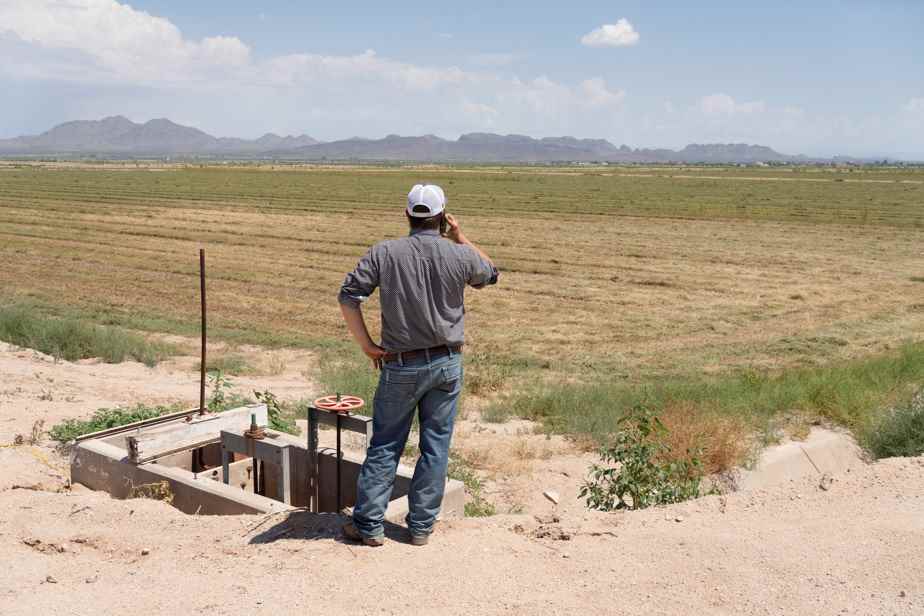Posted at 12:00 a.m.
Sorghum

PHOTO ARCHIVES AGENCE FRANCE-PRESSE
Sorghum cultivation in Bijie, southwest China
As a child, Bonnetta Adeeb always found sorghum syrup at home in the southeastern United States. A bit like the maple syrup in the cupboards on this side of the border, she explains. “But there are so many other uses,” the founder of the Ujamaa Cooperative Farming Alliance organization said over the phone. It can be used to make milk, like oats, for bread, cereals, like rice… The leaves can also be used. »
-

PHOTO ROD AYDELOTTE, ASSOCIATED PRESS
Transformation of sorghum into syrup during a festival on September 5, near Waco, Texas
-

PHOTO ROD AYDELOTTE, ASSOCIATED PRESS
Transformation of sorghum into syrup during a festival on September 5, near Waco, Texas
-

PHOTO ROD AYDELOTTE, ASSOCIATED PRESS
Texas sorghum harvest
1/3
The retired teacher wanted to help farmers and gardeners in Black, Indigenous and Colored communities learn about traditional seeds. Bonnetta Adeeb is particularly proud to pass on her knowledge of sorghum, a nutritious cereal originating in Africa, easy to grow, but which remains little known. “Sorghum is grown all over the world,” she adds. It is adapted to the climate. It grows well in poor soil, it requires one-sixth of the water [d’autres cultures populaires]. If it weren’t for sorghum, people in East Africa would struggle and go hungry. »

PHOTO EDUARDO SOTERAS, AGENCE FRANCE-PRESSE ARCHIVES
Women sift sorghum grains in a village in Ethiopia.
This grass caught the attention of the French media during heat waves, when sorghum farmers fared better than other farmers.

PHOTO SARAH MEYSSONNIER, REUTERS ARCHIVES
A French farmer in his sorghum field near Saint-Escobille last August
Amaranth

PHOTO PRAKASH MATHEMA, AGENCE FRANCE-PRESSE ARCHIVES
Amaranth cultivation on the outskirts of Kathmandu, Nepal
The day after Halloween, on the Day of the Dead, Mexicans used to fashion skulls with grains of amaranth, a pseudocereal with nutritional properties comparable to those of quinoa. They mixed it with honey to make a delicacy, in the Aztec tradition.
“It’s Mexico’s gift to the rest of the world, which is not quite realized,” said Tennessee State University professor Matthew Blair. Fascinated by the properties of the plant, he is the president of the Amaranth Institute, which aims to make this pseudocereal known.
-

PHOTO PROVIDED BY LUFA FARMS
Red amaranth microgreens
-

PHOTO EDOUARD PLANTE-FRÉCHETTE, LA PRESSE ARCHIVES
Amaranth grains
1/2
He is full of praise for this grain which, although it is native to Mexico and South America, has begun to spread everywhere due to its resistance to the dry climate, in a soil laden with salt. and low humidity. As this grain, which is smaller than quinoa, is harvested in the fall, it allows producers who have more than one crop to benefit from a longer season. “In addition to the issue of food safety, I think it’s important to think about the food industry,” he adds. Even a small family business can benefit from it. » Amaranth is used in breakfast cereals, candies, nutrition bars.
Pearl millet

PHOTO GETTY IMAGES
Millet cultivation in India
From West Africa to Asia to Texas, pearl millet is grown in many parts of the world. You can even find them… in Quebec. “It’s very marginal, if not experimental,” says consultant agronomist Pierre Bélanger. The challenge here is to figure out how to adapt it to the cold — and to prevent the birds from feasting on the fields, since they are very fond of the grain, which is not protected by leaves.

PHOTO EDOUARD PLANTE-FRÉCHETTE, LA PRESSE ARCHIVES
Millet grains
But for countries affected by heat waves and droughts, pearl millet is rather life-saving. It helps to “restore the moisture balance” of the soil, which makes it interesting in rotational crops, says Mr. Bélanger. “The potato crop, for example, is a crop that is demanding on the soil, it enormously reduces the amount of organic matter in the soil, he explains. Therefore, the cultivation of forage millet makes it possible to restore the soil’s moisture balance. In West Africa, when the soil is too undernourished for maize to grow, farmers turn to pearl millet, he says. The grass can be used for its flour or in a porridge, for example.
Fonio and African rice

PHOTO FROM WIKIMEDIA COMMONS
Fonio cultivation in Senegal
Fonio is considered the longest cultivated cereal on the African continent, for thousands of years. It looks a bit like millet or white quinoa. It is found particularly in the cuisines of West Africa. It is resistant to heat and the absence of water and it reaches maturity quickly, in addition to having interesting nutritional properties.
The Senegalese chef Pierre Thiam, based in the United States, has helped to make the cereal known in his host country. Fonio is used a bit like rice or couscous. “We are in contact with growers in West Africa who grow fonio and millet,” says Ms.me Adeeb. But another plant interests us: African rice. We have African rice varieties in Louisiana and Georgia. This type of rice requires less water than the traditional grain grown in Asia, she points out, which makes it an attractive choice for drier environments.
With The Guardian

